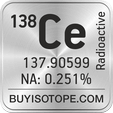138Ce Isotope Applications:
Cerium-138 isotope (Ce-138 isotope, 138Ce isotope)
- 138Ce isotope is used for research in nuclear physics;
138Ce isotope is available to order from BuyIsotope.com in 138Ce oxide (CeO2) chemical form. Please contact us via request a 138Ce quote BuyIsotope.com to order 138Ce isotope, to get 138Ce price and to buy 138Ce isotope.
138Ce Safety Data Sheet (SDS) in oxide form - Download pdf file
Download 138Ce SDS in oxide form
Properties of 138Ce Isotope:
| Properties of 138Ce Isotope: | 138Ce |
|---|---|
| Natural Abundance (%) | 0.251 |
| Atomic Mass (Da) | 137.905991 |
| Relative Isotopic Mass | 137.905991 |
| Neutron Number (N) | 80 |
| Atomic Number (Z) | 58 |
| Mass Number (A) | 138 |
| Nucleon Number (A) | 138 |
| Proton Number (Z) | 58 |
| Half-life | 4.400E+16 |
| Spin | 0 |
| Quadrupole Moment | 0 |
| g-factor (g value) | 0 |
| Group | ― |
| Period | 6 |
| Electron Configuration Block | f |
| Melting Point (K) | 1068 |
| Boiling Point (K) | 3716 |
| Specific Heat | 0.205 |
| Heat of Formation | 420.1 |
| Thermal Conductivity | 11.3 |
| Dipole Polarizability | 205 |
| Electron Affinity (kJ/mole) | 0.57 |
| Electronegativity (Pauling scale) | 1.12 |
| Atomic Radius (pm) | 181.8c |
| Covalent Radius (pm) | 185 |
| VDW Radius (pm) | 274 |
| Lattice Constant | 5.16 |
| Crystal Structure | DHCP (β-Ce) / FCC (γ-Ce) |
| Jmol color | #ffffc7 |
138Ce Information
Cerium is a silvery metallic element, belongs to the lanthanoids. There are 39 isotopes of cerium. 4 isotopes of cerium are natural and they are stable. This element is used in some rare-earth alloys. The oxidized form of cerium is used in the glass industry. Cerium was discovered by Martin H. Klaproth in 1803.
Cerium oxides are used in the optics and glass-making industries. Its salts are used in the photography and textile industry. Cerium is used in high-intensity carbon lamps and as alloying agents in special metals.
FAQ about 138Ce Isotope:
What is 138Ce isotope natural abundance?
Answer: 0.251 %
What is atomic mass for 138Ce isotope?
Answer: 137.90599 Da
What is isotopic mass for 138Ce isotope?
Answer: 137.90599
How many neutrons does 138Ce isotope have?
Answer: 80
How many protons does 138Ce isotope have?
Answer: 58
How many electrons does 138Ce isotope have?
Answer: 58
What is atomic number for 138Ce isotope?
Answer: 58
Is 138Ce isotope stable?
Answer: No
Is 138Ce isotope radioactive?
Answer: Yes

